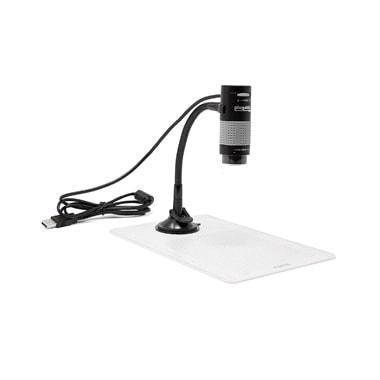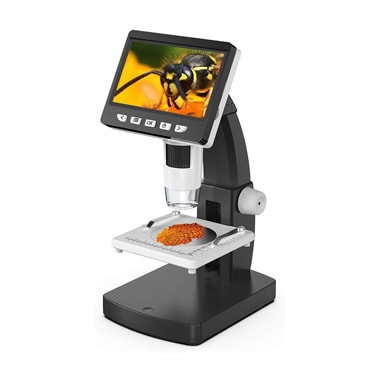8 Best Microscope Cameras in 2025 – Reviews & Top Picks
Last Updated on

Microscopes have come a long way, and today, they can even take high-definition photos and videos of whatever is beneath the lens. Some have built-in screens for easy viewing and can even offer completely wireless functionality with rechargeable USB batteries. Most of them will hook up to computers, televisions, and even smartphones.
While some of these devices offer incredible performance, others tend to freeze, have poor color reproduction, or don’t have great compatibility. To make sure you get a device that will meet all of your needs, we’ve put together the following reviews comparing our top eight picks for the best microscope camera. These are all functional devices, but only the top three have earned our recommendations.

A Quick Comparison of Our Favorites (2025 Update)
| Image | Product | Details | ||
|---|---|---|---|---|
| Best Overall |
 |
SKYBASIC LCD Digital Microscope |
|
CHECK PRICE |
| Best Value |
 |
Plugable Microscope Camera |
|
CHECK PRICE |
| Premium Choice |
 |
Opti-Tekscope Micro Macro Camera |
|
CHECK PRICE |
 |
Koolertron LCD Digital Microscope Camera |
|
CHECK PRICE | |
 |
PFC Optics Portable Microscope Camera |
|
CHECK PRICE |
The 8 Best Microscope Cameras:
1. SKYBASIC LCD Digital Microscope – Best Overall

With 50X and 1000X magnification levels to choose from, the SKYBASIC S307 digital microscope will let you see subjects in great detail. We would prefer a few more magnification levels in between these two, but thanks to the built-in 4.3-inch LCD screen, you won’t need any additional cables, computers, or screens to see what you’re working with. Additionally, a USB rechargeable battery provides four hours of runtime so that you’re never tied to a cable with this microscope.
To make sure you can clearly see what you’re looking at, eight dimmable LED lights are built-in. We found them to be very helpful and usually left them on the brightest setting. Most of these microscope cameras require an SD card to be purchased separately, but the SKYBASIC includes an 8GB memory card pre-installed. The 2MP camera isn’t the best we’ve seen, but it can take impressive HD video up to 1080p. We think all the features add up to the best microscope camera overall, which is why the SKYBASIC is in our number one position.
- 50X and 1000X magnification
- Built-in 4.3” LCD screen
- 8 dimmable LED lights
- 8GB memory card installed
- USB rechargeable battery provides 4 hours run time
- 1080P HD video
- The camera is only 2MP
- Only 2 magnification levels
2. Plugable Microscope Camera – Best Value

Packed with useful features at an affordable price, we believe the Plugable USB2-MICRO-250X microscope camera is the best microscope camera for the money. With magnification up to 250X, you’ll be able to see the fine details in even the smallest of subjects. The 2MP camera takes snapshots at 1600 X 1200 pixels and 640 X 480 video so you can store what you see in fine detail. Because it’s so cheap, the Plugable microscope doesn’t include a built-in screen. However, it can be used with any screen by way of the included USB cable. The flexible microscope arm also allows you to easily adjust to any viewing angle or distance.
One of our biggest concerns with this model is poor color reproduction. No matter what screens we used, the colors we saw were not accurate to the true colors of what we were magnifying. We also would appreciate a more powerful camera, but at this price point, the performance of the Plugable is admirable as is.
- Very affordably priced
- Up to 250X magnification
- See the image on any screen by USB connection
- Flexible, adjustable microscope arm
- Only 2MP camera
- Poor color reproduction
3. Opti-Tekscope Micro Macro Camera – Premium Choice

Equipped with a 300X zoom, the Opti-Tekscope OT-M microscope camera is a high-definition device with top-notch results. It takes pictures that are 4032 X 3024 pixels, truly HD. You’ll be able to see with a clarity you’ve never experienced before as you project the image on any large HDMI screen. You can also use it with any Windows 10 computer, but it’s not compatible with Macs.
The built-in three-inch display makes it possible to complete your work without hooking up any additional cables. One of our favorite features was the two adjustable spotlights that allow you to fully illuminate any subject from whatever angle is needed. To top it all off, a one-year warranty is also included, so you can feel assured that your microscope will be around for some time to come. In the end, we think it’s one of the best models we’ve seen, but it’s too expensive to make it to our top position.
- 300X zoom
- Built-in viewing screen
- Two adjustable spot-lights
- Can use with PC screen
- Not compatible with Mac computers
- Very high price
4. Koolertron LCD Digital Microscope Camera

With a 3.5-inch LCD screen built-in and a rechargeable battery, this microscope camera from Koolertron can be taken on the go with no extra cables or accessories. Mind you, the battery only lasts two hours, so you’ll get limited use from it without a charging cable. It’s also very expensive, even considering its high-end performance. We were quite impressed with the 5MP camera on this device. It’s the most powerful camera we’ve seen on a microscope yet. Moreover, you get 20X-300X magnification, so you can really make use of that powerful camera. Like other similar models, the Koolertron can hook up to your PC for transferring photos and using a larger screen. Thankfully, it’s compatible with Mac as well. Altogether, we think it’s a great little unit, but the short battery life and high price have kept it from climbing into our top three.
- 5MP camera
- Built-in 3.5” LCD screen
- 20X-300X magnification
- The battery only lasts 2 hours
- Very expensive
5. PFC Optics Portable Microscope Camera

Compact and portable, this mini WiFi USB microscope camera from PFC Optics takes video up to 1920 X 1080 resolution. On a smartphone, you’ll even get 1080p resolution. Thanks to the flexible metal tripod, you’ll be able to position the device wherever it is optimal for best viewing. If you’re having trouble seeing, the eight adjustable LEDs will illuminate your subject so that you’ll get a bright and clear image every time.
While the overall use of this device is fine, it fails in a few major areas. The camera is only 2MP, but that’s forgivable. What we can’t forgive is the terrible smartphone app. The “Max-see” app was constantly freezing and made it nearly impossible to get a clear image. Every time you would get the image focused it would freeze. Since 1080p video is only possible on the smartphone app, this is a flaw that we can’t forgive. We were happy to see great compatibility with PC and Mac, but you won’t get HD video with either.
- Connects to PC, Mac, or smartphone
- 8 adjustable LEDs
- Very compact
- The camera is only 2MP
- The smartphone app is terrible
6. Jiusion 1000x Digital Microscope Camera

The Jiusion digital microscope camera is one of the cheapest units that we got our hands on. Of course, the build quality pretty much matches the price tag. It is small and compact, so you can easily transport it anywhere. The stand also made it simple to set a proper viewing angle, but it never stayed where we set it. Eight LED lights are incorporated to illuminate whatever you’re looking at. Even better, they’re adjustable and can be dimmed with a knob. Another adjustment knob changes the focus to help you dial it in.
This device is compatible with Mac, Windows XP and above, and Linux. It also works with Android smartphones, but it won’t work with the iPhone or iPad. No matter what system we used it with, we experienced near-constant freezing of the microscope. Not only did this become frustrating, but it’s also a big waste of our time. In the end, we don’t think that the Jiusion provides enough value, even at the low price it’s available for.
- Very cheap
- Adjustable brightness LEDs
- Doesn’t work with iPhone or iPad
- Weak stand doesn’t stay put
- Freezes often
7. YINAMA LCD Digital Microscope Camera

With a built-in LCD viewing screen that spans 4.3 inches, the YINAMA digital microscope allows you to see everything you need, even without being hooked up to any computer or similar screen. It’s also got a rechargeable battery that offers an impressive four-hour battery life. Combined, this makes the YINAMA a portable powerhouse that can be taken anywhere and used without cables or extra accessories. The images it takes are decent, but the video is even better at 1080p.
Though it sounds great at first glance, several flaws held this device back, which is why it’s all the way down towards the bottom of our list. First, it only offers two levels of magnification: 50X and 1000X. We’d prefer to have some options in between. Moreover, the colors that you see in images are not accurate to the real-life colors of the subjects you’re observing. We also had constant problems with this microscope freezing, a frustrating time-sink that we couldn’t get past. Worst, the unit stopped working entirely after just a few weeks of light use. It’s a pretty expensive model, so this was a major disappointment.
- Built-in 4.3” viewing LCD screen
- 4-hour battery life
- Only two levels of magnification
- Poor color reproduction
- Freezes often
- Stopped working after just a few uses
8. Sunnywoo USB Microscope Camera

More than just affordable, the Sunnywoo USB microscope is actually dirt-cheap. The build quality matches though, which is why this device rounds out the final position on our list. It features magnification from 40X to 1000X according to the manufacturer. In our testing, we felt that these numbers were highly exaggerated.
We can deal with some over-represented magnification numbers, but what we can’t deal with is a device that doesn’t work right. The Sunnywoo software wouldn’t install correctly, so we weren’t able to use it with almost any computer. It’s supposed to work with Windows, Mac, and Android, but all of these had issues recognizing this machine. It’s also incompatible with the iPhone, which seems like a major oversight in this day and age. The video and images it snaps are mediocre at best, never quite coming fully into focus. Altogether, this is one of the lowest-performing camera microscopes we tested and we don’t recommend it.
- Very affordable
- 40X-1000X magnification
- Doesn’t work with iPhone
- The software doesn’t install correctly
- Exaggerated magnification
- Several computers and smartphones wouldn’t recognize it

Conclusion
Whether you’re conducting science experiments, examining bugs, or working on fine equipment, a camera microscope can be a valuable tool. We’ve tested quite a few of them, and our reviews should have helped you to determine which ones are best to avoid and which ones are worth a second look. Our recommendation for the best microscope camera is the SKYBASIC LCD digital microscope camera. It features a built-in LCD screen for easy viewing, an included 8GB memory card and even eight dimmable LED lights. It takes 1080p HD video and the battery runs for four hours between charges.
For the best value, we think it’s hard to beat the Plugable USB2-MICRO-250X microscope camera. It’s very affordably priced, small and compact, and offers up to 250X magnification. The flexible microscope arm is fully adjustable so you can position it anywhere you need for the clearest viewing. Finally, our premium pick was the Opti-Tekscope OT-M HDMI Microscope Macro Camera. It’s got a built-in viewing screen but can still be used with any HDMI screen or PC. With zoom up to 300X, you’ll see everything in incredible detail, and two adjustable spotlights will illuminate it no matter what light conditions you’re working in.
Table of Contents
- A Quick Comparison of Our Favorites (2025 Update)
- The 8 Best Microscope Cameras:
- 1. SKYBASIC LCD Digital Microscope – Best Overall
- 2. Plugable Microscope Camera – Best Value
- 3. Opti-Tekscope Micro Macro Camera – Premium Choice
- 4. Koolertron LCD Digital Microscope Camera
- 5. PFC Optics Portable Microscope Camera
- 6. Jiusion 1000x Digital Microscope Camera
- 7. YINAMA LCD Digital Microscope Camera
- 8. Sunnywoo USB Microscope Camera
- Conclusion
About the Author Robert Sparks
Robert’s obsession with all things optical started early in life, when his optician father would bring home prototypes for Robert to play with. Nowadays, Robert is dedicated to helping others find the right optics for their needs. His hobbies include astronomy, astrophysics, and model building. Originally from Newark, NJ, he resides in Santa Fe, New Mexico, where the nighttime skies are filled with glittering stars.
Related Articles:
How to Clean a Refractor Telescope: Step-by-Step Guide
How to Clean a Telescope Eyepiece: Step-by-Step Guide
How to Clean a Rifle Scope: 8 Expert Tips
Monocular vs Telescope: Differences Explained (With Pictures)
What Is a Monocular Used For? 8 Common Functions
How to Clean a Telescope Mirror: 8 Expert Tips
Brightfield vs Phase Contrast Microscopy: The Differences Explained
SkyCamHD Drone Review: Pros, Cons, FAQ, & Verdict



